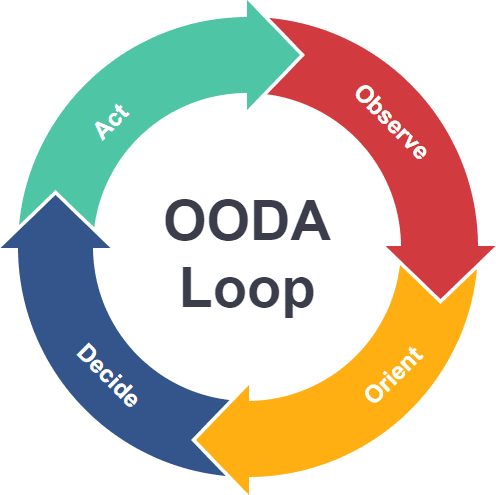What are OODA Loops? How Does it Help Making Decisions?
John Boyd, a fighter pilot in the Korean War, coined the term “OODA loop” to describe a continuous, recurring human decision-making cycle to make decisions under pressure.
The abbreviation OODA, which stands for Observe, Orient, Decide, and Act, describes the stages necessary to reach the right conclusion. The information strategy was created to defeat an opponent by inducing a sensation of paralysis. It was originally developed through Boyd’s work with energy manoeuvrability. The OODA loop’s phases (competitive cycles) each have its own cycle.
In practice, companies utilise the OODA loop to measure their response capacity, intending to improve (shortening/quickening) decision processes over time. Following the OODA cycle, stakeholders watch unfolding scenarios, orient themselves to assume a strategic footing, determine the best course of action to capitalise on that, and then act to take charge of the situation.
Also Read: What is TDODAR Decision Model?
Many everyday situations are volatile, unpredictable, complex, and ambiguous (VUCA). Surviving and winning in this circumstance is dependent on making more competent judgments. However, most businesses fail to improve the quality of their decision-making. For example, if a corporation continues to make decisions that do not yield a favourable return, it fails to learn from its mistakes. The OODA loop recognises this behaviour and offers a method for making corrections.
The OODA loop, now used in several areas, was invented in the mid-20th century by US Air Force Colonel John Boyd, a military strategist. It was first designed to teach soldiers to quickly make time-sensitive judgments when there may not be enough time to obtain all the necessary information. The strategy aimed to execute the OODA loop process faster than an opponent to penetrate and disrupt the enemy’s decision cycle.
How Does OODA Loop Work?
Like other problem-solving processes, the OODA loop is an interactive, iterative process that involves repeating the cycle, watching and measuring results, assessing and changing the initial choice, and progressing to the next stage. While the procedure is not always straightforward, the four distinct steps are as follows:
Step 1 – Observe
Observing is the first step in the OODA loop, which is important for a number of reasons. First, watch for any alterations, occasions, stimuli, or other events that occur in the context of interest, including internal conditions. This is equivalent to data collection in the business sector, where all information about the present organisational condition, any rivals, and the market is gathered.
Realising that the world is complicated is essential to the observation stage. Every data is a snapshot in time and must be treated as such. As a result, organisations must acquire whatever information is accessible as soon as feasible to make judgments based on it.
Step 2 – Orient
The orienting phase consists of thinking about what was discovered during observations and deciding what should be done next. Making a conscious decision necessitates a high level of situational awareness and comprehension. Because some decisions are unconscious or instinctual, this stage entails thinking about what and why decisions are made before deciding on a plan of action. Situational models may be constructed in organisational applications using machine learning (ML) methods to detect likely outcomes while reducing bias.
Step 3 – Decide
The decision phase recommends an action or reaction plan, considering all possible outcomes. This may be achieved by holding meetings or discussions centred on developing a roadmap for the entire organisation.
Step 4 – Act
Action refers to carrying out the decision and making the necessary modifications in response to the decision. This stage may also contain any necessary testing before launching an action, such as compatibility or A/B testing.
OODA Loop-related terminology
Manoeuvre warfare- This is a military strategy that emphasizes disrupting the enemy’s decision-making abilities in order to vanquish them. Manoeuvre warfare is based on the concepts of deception and surprise. The concept of the OODA cycle was derived from the manoeuvre warfare strategy.
Mental models are representations or explanations of human behaviour that exist on a personal or internal level. A person can generate a mental model to understand their thought processes, decisions and consequences. Mental models are a part of the orientation step of the OODA loop.
Situational awareness– This is the comprehension of all environmental stimuli. It involves perceiving components of a situation, understanding what they mean and using them to make future judgments. Achieving situational awareness is crucial for most decision-making processes, including the OODA loop.
Reaction time– This term refers to the interval between a stimulus and the response to that stimulus. The primary objective of the OODA loop is to reduce the reaction time of an individual or organization.
Factors that Play a crucial role in OODA Loop
OODA loops are only as good as the time it takes to perform a reaction. The following factors can have an impact on the process’s efficiency:
- The number of possible situations that may be investigated.
- Denial of the occurrence of a certain event and refusal to recognize it immediately.
- The stimulus’s intricacy.
- The requirement for approval before carrying out a response.
- The team’s or environment’s emotional tension at the commencement of the stimulation.
- The degree to which members of a team can rely on one other’s choices.
- The level of intuitive talent possessed in relation to the input.
- Business objectives that are clearly or ambiguously articulated.

Advantages of Using OODA Loops
Implementing the OODA cycle in an organisational setting may bring the following advantages:
- Allows for faster, more simplified decision-making processes.
- Individuals are trained to have a faster reaction time.
- Reduces friction for all parties engaged in decision-making.
- Makes the environment more dynamic, versatile, and competitive.
- Enhances organizational openness and situational awareness.
- It encourages creativity and innovation.
- Preparedness is emphasized as the key to successful decision-making.
- Rather than ambiguity, it focuses on certainty.
Disadvantages of using OODA Loops
When not implemented effectively or used in improper settings, the OODA cycle might have the following drawbacks:
- It might be difficult to comprehend or interpret in a variety of ways.
- Organizations are more likely to face dangers as a result of making a choice too quickly.
- It may be more difficult to “undo” a mistake.
- Teams may develop a false feeling of credibility as a result of this.
- Can disregard the concept of repeating techniques from previous instances, as the OODA cycle must be completed in its full each time.
- Does not account for the additional response times that come with teamwork.
- Does not always consider the possibility that the opponent is also using the OODA loop.
Conclusion
The OODA loop decision-making process is a methodology developed by the military that entails four stages: observe, orient, decide, and act. The advantage of it is the flexibility with which it is applicable in all decisions made, whether in the military or in an office setting. While facing any situation, one ought to first discern what is around carefully and come to terms with the facts as they are in real-time. Consequently, one is expected to be able to relate to current happenings. This part is the most important part of the loop since it sets the basis for a complete understanding of the actions and reactions in real-time, an ability that could lead to you being able to predict your opponents’ next move. After orientation, a decision is bound to be made, and it can be right or wrong, but either way, it will be determined by the individual understanding. The final step, sometimes very difficult for some people, is acting on the decision. Implementation might face delay mostly due to the human nature of coming to so many theoretical conclusions based on the different perspectives at the observation stage.

